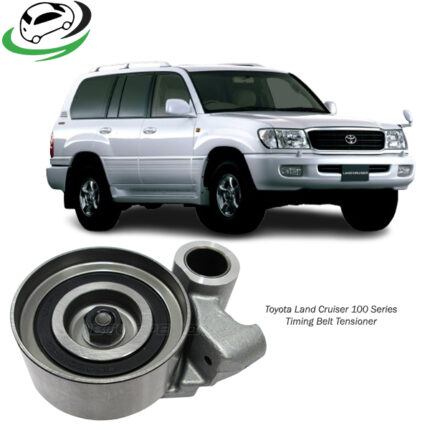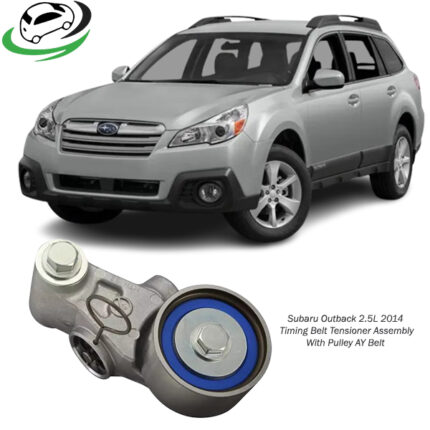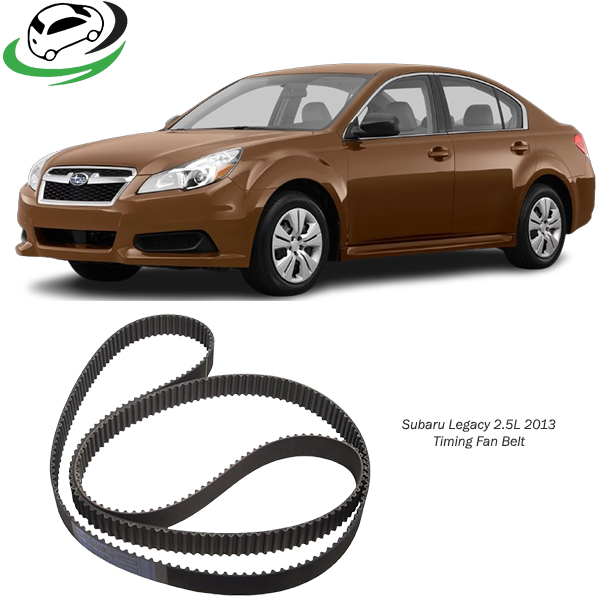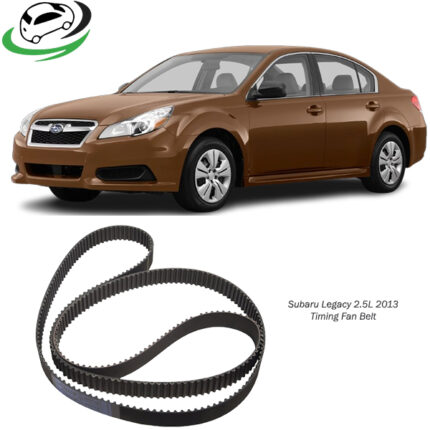-5%
Get Subaru Legacy 2.5L 2013 Timing Fan Belt 13028AA240
The timing fan belt, commonly referred to as the “serpentine belt” or “fan belt,” is a critical component in a vehicle’s engine. It powers various auxiliary components, such as the alternator, power steering pump, water pump, and air conditioning compressor. Though it does not directly affect engine timing like the timing belt, its proper function is crucial for the vehicle’s overall performance. In this comprehensive explanation, we will discuss the function, benefits, types, and maintenance tips for the timing fan belt in detail.
1. Function of the Timing Fan Belt
The primary function of the timing fan belt is to drive multiple engine accessories simultaneously. It operates by transferring mechanical energy from the crankshaft pulley to various components that rely on engine power for their operation.
Key Components Driven by the Fan Belt:
- Alternator: The alternator charges the vehicle’s battery and powers the electrical systems when the engine is running. The serpentine belt drives the alternator by transferring rotational energy from the crankshaft.
- Water Pump: The water pump circulates coolant through the engine to maintain optimal operating temperature and prevent overheating. Depending on the engine design, the fan belt may power the water pump.
- Power Steering Pump: This pump helps reduce the effort required to turn the steering wheel, providing smoother and more controlled steering, especially at low speeds.
- Air Conditioning Compressor: The A/C compressor is driven by the fan belt, enabling the air conditioning system to function by compressing refrigerant gas into a high-pressure liquid.
- Radiator Fan (in older vehicles): While many modern vehicles use electric fans, older cars often use a belt-driven fan to pull air through the radiator for cooling.
How It Works
The fan belt wraps around pulleys connected to the crankshaft and accessory components. As the crankshaft rotates, it drives the fan belt, which in turn powers the accessories. The belt’s tension is maintained by a belt tensioner (either spring-loaded or manually adjustable), which ensures proper alignment and minimizes slack.
2. Types of Timing Fan Belts
There are generally two types of belts used in modern vehicles: the V-belt and the serpentine belt. The choice of belt depends on the vehicle’s design and the number of accessories that need to be powered.
a) V-Belt
V-belts were common in older vehicles and typically power individual components. These belts have a V-shaped cross-section, which helps them fit into the pulleys more securely. Vehicles using V-belts may have multiple belts for different accessories, such as the alternator, power steering pump, and air conditioning.
b) Serpentine Belt
Most modern vehicles use a serpentine belt, a single, continuous belt that winds through various pulleys and drives multiple components at once. Serpentine belts are flat with multiple grooves on the underside, providing more surface area for the belt to grip the pulleys. This design offers several advantages over the older V-belt system, such as better efficiency, easier maintenance, and fewer belts to replace.
3. Benefits of a Well-Functioning Timing Fan Belt
A properly functioning timing fan belt ensures the smooth operation of the engine and the vehicle’s auxiliary systems. Some key benefits include:
a) Powers Essential Systems
The most important benefit of the fan belt is that it powers various engine accessories necessary for the vehicle’s operation. Without a functioning belt, critical systems such as the alternator, power steering, and water pump would not operate, leading to serious vehicle malfunctions or even engine damage.
b) Improved Engine Efficiency
Serpentine belts are more efficient than their V-belt counterparts because they require less power to drive multiple components. By consolidating the drive mechanisms, serpentine belts reduce the overall strain on the engine and help improve fuel economy.
c) Smoother Engine Operation
A correctly tensioned fan belt ensures smooth and consistent power delivery to the vehicle’s accessories. It prevents slippage and ensures that the alternator and power steering function at optimal levels, providing a smoother driving experience.
d) Reduced Maintenance Complexity
One of the advantages of serpentine belts over V-belts is the simplicity of their design. Since only one belt drives all the accessories, replacing or maintaining the belt system is more straightforward, reducing labor costs and vehicle downtime.
e) Longevity
Serpentine belts are made from durable rubber compounds, often reinforced with materials such as polyester or Kevlar, which help them withstand the heat, stress, and wear of continuous operation. When properly maintained, they can last up to 100,000 miles or more before requiring replacement.
4. Common Issues with Timing Fan Belts
Over time, the timing fan belt can wear out or develop issues due to constant exposure to heat, friction, and mechanical stress. Here are some common problems that can affect the belt’s performance:
a) Cracking and Fraying
As the belt ages, it can develop cracks along the ribs or edges. This is often due to heat and constant tension. If the cracks become severe, the belt may eventually break.
b) Glazing
A glazed belt has a shiny, smooth appearance and may slip on the pulleys instead of gripping them properly. This can happen when the belt is exposed to excessive heat or becomes too loose. A glazed belt will need to be replaced as it cannot effectively drive the engine’s accessories.
c) Squealing Noise
A common symptom of a worn or loose belt is a squealing or chirping noise, particularly when starting the vehicle or when the engine is under load. This noise typically indicates that the belt has lost its tension or is misaligned on the pulleys.
d) Belt Slippage
If the belt is too loose or misaligned, it may slip off the pulleys, causing a loss of power to the accessories. Belt slippage can lead to overheating, a dead battery, or loss of power steering.
e) Belt Breakage
In rare cases, the fan belt can break entirely, leading to a complete failure of the vehicle’s accessories. This can cause the engine to overheat or lose power, and the vehicle may become inoperable until the belt is replaced.
5. Maintenance Tips for Timing Fan Belts
Proper maintenance of the fan belt can extend its lifespan and prevent unexpected breakdowns. Here are some key maintenance tips:
a) Regular Inspection
The fan belt should be inspected periodically for signs of wear, cracking, glazing, or fraying. Visually check the belt for any abnormalities and listen for unusual noises when the engine is running. If any issues are detected, it’s best to replace the belt before it fails.
b) Check Belt Tension
A fan belt that is too loose or too tight can cause problems such as noise, slippage, or premature wear. The belt tension should be checked regularly using a belt tension gauge or by observing how much deflection occurs when pressing down on the belt. If the belt is too loose, adjust the tensioner or replace the tensioner if it is faulty.
c) Replace the Belt on Schedule
While fan belts are designed to last for many miles, they will eventually wear out. Most manufacturers recommend replacing the serpentine belt every 60,000 to 100,000 miles, depending on the vehicle and driving conditions. Be sure to follow the vehicle’s maintenance schedule to avoid unexpected belt failures.
d) Replace Belt Tensioner and Pulleys if Necessary
The tensioner and idler pulleys are responsible for maintaining the correct belt tension and alignment. Over time, these components can wear out, causing the belt to slip or lose tension. If the tensioner or pulleys show signs of wear, they should be replaced along with the belt.
e) Address Fluid Leaks
Fluid leaks, particularly oil or coolant, can cause the fan belt to deteriorate prematurely. If any leaks are detected near the belt, they should be repaired as soon as possible to prevent contamination and damage to the belt.
6. Signs of a Failing Fan Belt
Recognizing the warning signs of a failing fan belt can prevent more serious issues from developing. Some common signs include:
- Squealing or chirping noise from the engine, especially when accelerating or turning on accessories like the air conditioner.
- Visible cracks or wear on the belt.
- Loss of power to accessories such as the alternator, power steering, or air conditioning.
- Engine overheating, which could indicate a belt-driven water pump failure.
- Battery warning light or power steering warning light on the dashboard.
Conclusion
The timing fan belt is a critical component that powers various accessories in a vehicle’s engine. While it may seem like a simple part, its proper function is essential for the vehicle’s performance and reliability. Regular inspections, timely replacement, and proper maintenance of the fan belt can prevent costly repairs and ensure that your vehicle runs smoothly. Always adhere to the manufacturer’s recommendations for maintenance and replacement intervals, and consult a professional mechanic if you experience any signs of belt failure.
Follow us on Facebook for more parts.





Reviews
Clear filtersThere are no reviews yet.